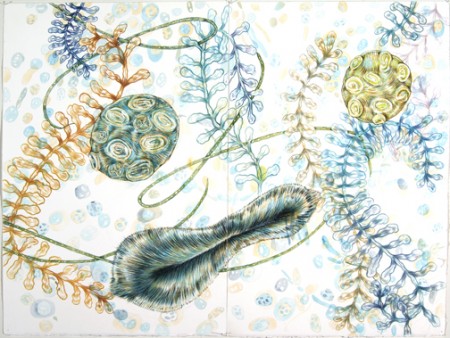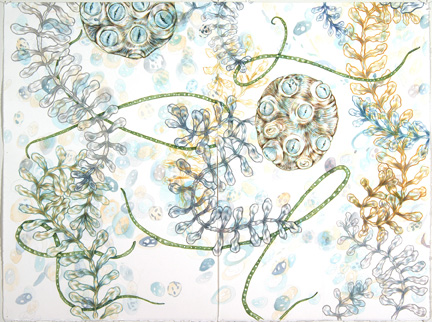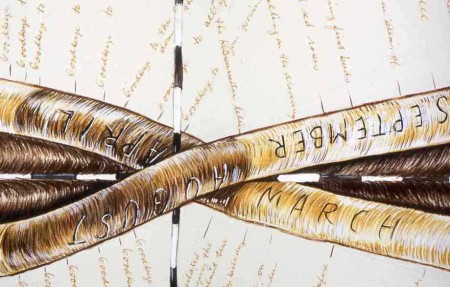“Drawing has always been a way to interact with what I see and feel – that could be the material world or the world of dreams and memory or some combination of all of these,” explains Cincinnati artist Kate Kern who studied at the University of Dayton (BFA) and the University of Cincinnati (MFA in drawing). “I often draw on (in all senses) other representations of the world, whether that be 19th-century medical texts, old high school year books (sic), or library card catalogs. I invite others into my drawn world that is at once cheerful and creepy in hopes that they too experience its contradictory emotions: tenderness and anxiety, sorrow and humor.”
“Contradictory” is Kern’s assessment of her work, but the word that came to my mind, when I viewed her exhibition at Kennedy Heights Arts Center (KHCA), was “duality.” I see it expressed in its very title: “Drawing on Second Sight.” As she notes, taken as a verb drawing on can suggest taking inspiration from a source or drawing ona support. The result is a drawing, a noun. Similarly “second sight” can mean taking another look – looking back; alternatively it describes clairvoyance or precognition – looking forward.
The exhibition itself has two parts. One is the presentation of her drawings, books, and a site-specific installation in the Lindner Gallery in KHCA’s annex. The second part is Kern’s ongoing 24-month online project at its halfway point: www.secondsight.net. Her aim here was “to revisit, reconnect, and share 30+ years of my studio work.” In weekly blog posts, she discusses one work, perhaps its specific inspiration or how it’s made, e.g. This archive is not chronological but grows organically by “linking some aspect of the previous post to the current one and using tags as a creative way to search the ongoing entries,” per the secondsight.net site.

There is one quality in Milwaukee native Kern’s work that remains a constant in my mind – lyricism. Nowhere is this more eloquently expressed than in two drawings from 2006: For You Yet Give and Hath and Whom. Kern uses washes of pastel-colored drawing ink over pencil to create what might be an aquatic or celestial environment, or a microscopic world. Spring-green “ribbons” loop through this atmosphere, accentuated with carefully marshaled dots. There are stems with leaves or petals evenly spaced along them, or are they spines with odd vertebrae? Whether flora or fauna, they seem to respond to currents – water or air.

Orbs, covered with non-human eyes, levitate in the ether. Kern opines on the wall label: “All they appear to be able to do, other than float, is to see. This omniscient ability is something we all attribute to divine beings with unearthly power.” She continues, “This is an image I return to often, and with it I am thinking this all-seeing ability – without other means of connecting, sensing, feeling, sharing – would be infinite and at the same time (author’s italics) cruelly finite and limited.” Kern might see this as “contradictory,” but again I prefer seeing it as a “duality,” two sides of the same coin.

Goodbye Old Year is very affecting, but you must come in for a closer look. The wormlike (Kern’s own description) infinity symbol — the number eight, a favored motif, lying on its side — is divided into 12 parts in a range of sepia tones. She has labeled them with the names of months. Narrow strips of paper trail from each section, each with a phrase related to the month. These strips look like ticker tape or the narrow strips of telegrams. (Could these continuous strips carrying messages relate to the rolls of paper fed through dot-matrix printers in days of yore?)
Two strips describe an event unique to December: the winter solstice. In cursive writing (an endangered art no long taught in schools), the artist has written “Goodbye to your longest night” and “Goodbye to your shortest day.” From April there is the hopeful “Goodbye to your last frost.” Although the phrases are matter-of-fact, they also communicate a sense of nostalgia or melancholy.
In Kern’s site-specific installation, Second Sight Canopy, a rectangular piece of plastic netting of the type used to keep deer away, is suspended by its corners above a visitor’s head. Spanning the approximately 18’ width of the moderately sized gallery (18’ x 35’), it sags like a hammock although the things that Kern has attached to the net aren’t heavy enough to cause that. She uses “a mixture of old and new elements, reflecting the goals of my Second Sight online project to use the process of looking back at past work in order to move forward, making new connections and new work.” Kern used “ephemera made from small items from my archive combined with work samples/tests, and recycled parts of other installations. This combination of work was selected for its themes of time, timelessness and perception, and its repeated layering of the experience of individual time passing with the concepts of universal/seasonal/celestial patterns moving across time.”
For its maker, Second Sight Canopy “serves as an active archive piece, juxtaposing layers of ephemera from my studio work and correspondence from 1983 through the present.”
Among the items attached are painted seed packets, chiffon, lace, paint and glitter, gold birds cut from wrapping paper, a mail-art envelope from Joel Lipman, and photocopied human eyes from her 1000 Eyes project collaged onto photocopies of rare blue butterflies taken from a scientific text, to name a few.
Looking up at the Second Sight Canopy requires you to crane your neck, an uncomfortable position, just as looking back over your life can sometimes be. And its location reminds us that the past always hangs over us.
–Karen S. Chambers
“Drawing on Second Sight,” Lindner Gallery, 6620 Montgomery Rd., an annex of Kennedy Heights Art Center, 6546 Montgomery Rd., Cincinnati, OH 45213; 513-631-4278, fax: 513-631-1723, www.kennedyarts.org. Mondays-Fridays, 10 a.m. – 5 p.m.; Saturdays, 11 a.m. – 4 p.m. Through July 30, 2016.